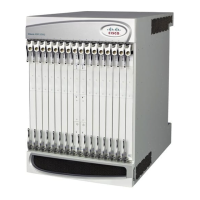External Storage System Overview
▄ Cisco ASR 5000 Series Product Overview
Overview
The CDR subsystem, provides 512 MB of volatile memory on the packet processing card RAM to store accounting
information. This on-board memory is intended as a short-term buffer for accounting information so that billing systems
can periodically retrieve the buffered information for bill generation purposes. However if network outages or other
failures cause billing systems to lose contact with the system, it is possible that the CDR subsystem storage area can be
filled with non-retrieved accounting information. When the storage is filled the CDR subsystem starts deleting the oldest
files to make sure that there is room for new billing files and non-retrieved accounting information can be lost. Using an
external storage server with a large storage volume in close proximity to the chassis ensures room for storing a large
amount of billing data that is not lost by any failure.
The ESS has the capability of simultaneously fetching any types of files from one or more chassis. That is, it can fetch
xDRs like CDR, EDR, NBR, UDR file, etc.
In case of Hard Disk Drive (HDD) support on the chassis, the platform has the capability to push the xDR files to L-
ESS, and then L-ESS forwards these files to the required destinations. If HDD is not configured on the platform, L-ESS
pulls the files from the system and forwards them to the destinations.
The External Storage System (ESS) is designed to be used as a safe storage area. A mediation or billing server within
your network must be configured to collect accounting records from the ESS once it retrieves them.
The External Storage System supports a high level of redundancy for secure charging and billing information for post-
processing of xDRs. This system can store charging data of up to 30 days.
This guide discusses the following topics on External Storage System:
Storage System Components:
Local, short-term external storage server (L-ESS)
The following figure shows a typical organization of External Storage System including L-ESS and billing system with
chassis having a AAA server.

